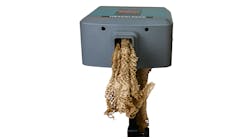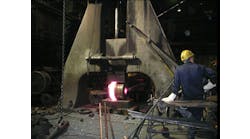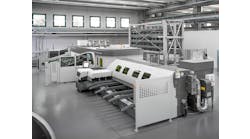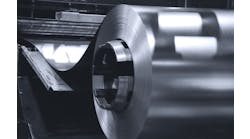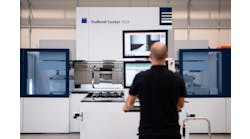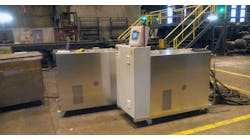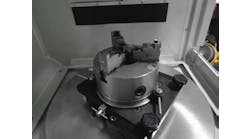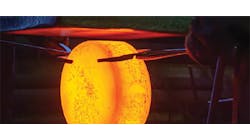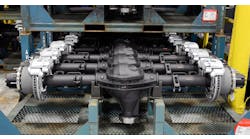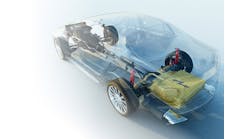Q: Please describe special cooling- rate controls for microalloy steel forgings. We are producing microalloy steel forgings, and we need to understand more about how to control the cooling rates of these products in order to meet the property indications. We understand that the forgings must be cooler than about 1,200°F before they reach the tote boxes. However, our conveyor is not nearly long enough for this, even when we slow it down.
A: Microalloy forging should be viewed as a thermo-mechanical process requiring proper controls on forging temperature, forging reductions, and post forging cooling rates, all combined with an acceptable level of “certifiability” of the process with records not all that different from those typically required for heat treatments. The processes actually eliminate the typical normalizing and tempering operations performed on forgings requiring specific mechanical properties. In some cases, the process actually replaces a hardening tempering cycle for some grades of steel.
The equipment and facilities may include the following:
1. Heating equipment capable of temperature controls in the range of +/- 50ºF to ensure consistent heating of billets and/or slugs prior to forging. Thermocouple readouts and corresponding strip charts could become vital. If induction heating, then recording data off of radiation pyrometers would be of value for reporting data that customers usually like.
2. Optical or radiation pyrometer readings and corresponding documentation on the post-forging temperature ranges.
3. Controlled, or at least consistent, cooling rates using appropriate conveyors to permit uniform cooling of each part after forging.
4. Verifications of cooling-rate uniformity supported with appropriate hardness checks on cooled parts. This usually involves conveyors with variable- speed drives to permit adjustment of the proper cooling rates, followed by establishing a “norm” to be used for future orders of the same forgings. Records of speeds and times are an essential ingredient to ensure repeatability of mechanical properties. (Again, these requirements are similar to those regarding heat-treating records.)
5. Appropriate dispositions on parts that are cooled at non-standard rates for inspection purposes. In some cases, these parts may need to be scrapped or heat treated to match the properties produced by the developed production process.
6. Proper records of hardness checks, calibrations on hardness testers, and most all that goes along with normal certified heat treatments.
7. The usual lot-control system in place for tracking individual heats of steel, such as heat-code stamps or lot code identifications on the forgings.
8. Carry-through of such identification through postforging processes, such as grit or shot blasting, spot machining, etc.
9. Possible bench testing to permit appropriate product tests on full parts, as determined by the customer.
10. Metallographic examination to verify that the processes being used are achieving the target grain sizes of ASTM 4 or finer, or ASTM 5 or finer, depending on the microalloy grade selected.
11. Forging equipment that is 10 -15% greater in capacity than would be used for the same parts under “normal” forging conditions. More often, there is no real need for such a change because forgings are rarely sized precisely to the minimum forging machine used.
For larger parts, it may be necessary to install one or more fans to speed up the air-cooling cycle, and in turn to ensure a proper hardness response. This may be especially important for forgings that have section sizes larger than about 2.5 in. thick. This may also reduce the length of the conveyor(s) needed to ensure sufficiently low temperatures before entering the final boxes.
There is at least one instance reported where a fine water spray is used to reduce the temperature of forgings from over 2,000ºF to below 1,600ºF before continuing the aircooling cycle. This is an especially important consideration for sections larger than about 3 in.
For crankshaft forgings, the use of tracked chain/roller conveyors is important to ensure proper cooling and to minimize distortion. The crankshafts actually hang vertically by the clutch face flanges as they travel around the conveyor.
Sometimes it is acceptable practice to place forgings on conveyorized individual trays that permit uniform, but individual, cooling cycles. Here again, water-mist spray cooling systems can be used to accelerate the cooling of heavy-section crankshafts and to ensure uniformly controlled cooling, hence proper control of hardness.
For more than 40 years H. James Henning held key technical positions in the forging industry, including as director of technology for the Forging Industry Association, and as president of Henning Education Services, a Columbus, OH, firm specializing in customized education and training in forging technologies.
Guidelines and recommendations offered in this column are based on information believed to be reliable and are supplied in good faith but without guarantee. Operational conditions that exist in individual plants and facilities vary widely. Users of this information should adapt it, and always exercise independent discretion in establishing plant or facility operating practice.
